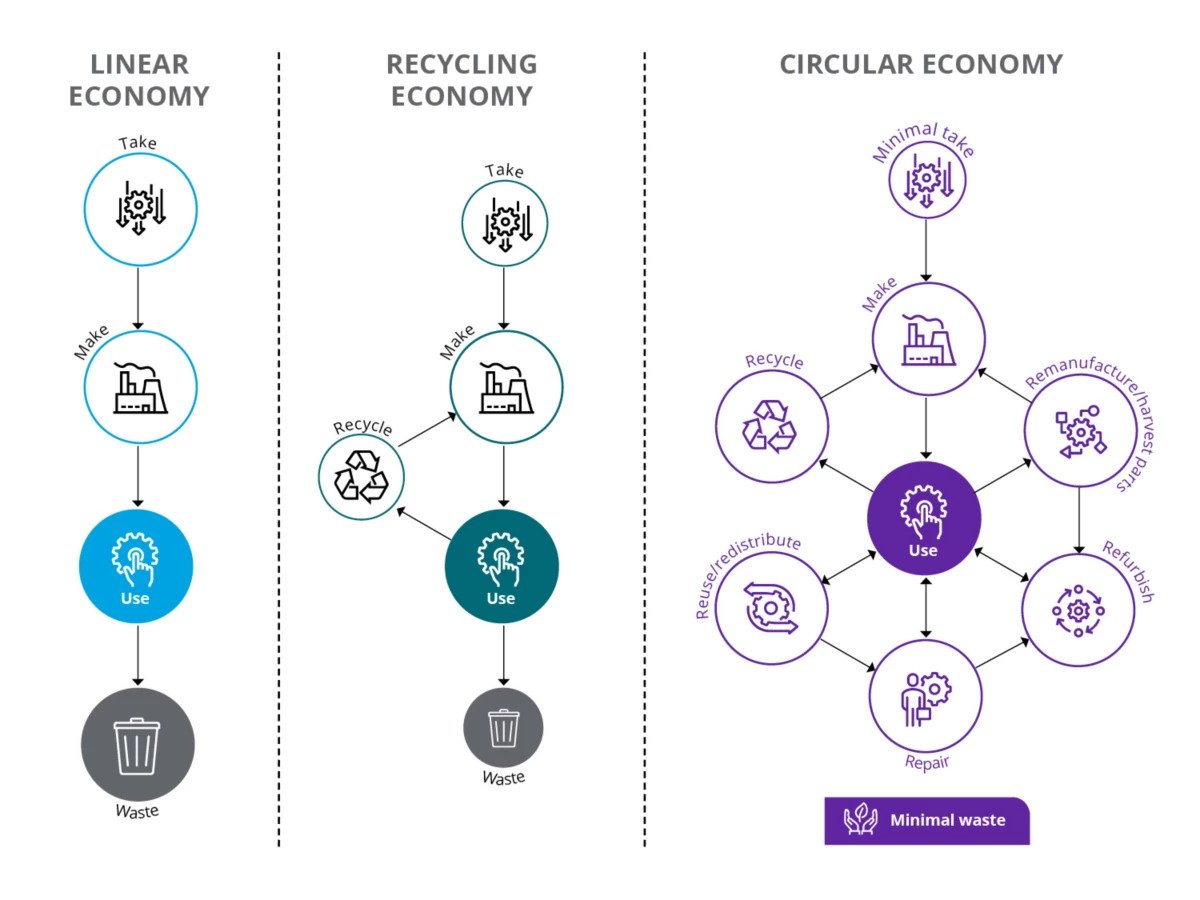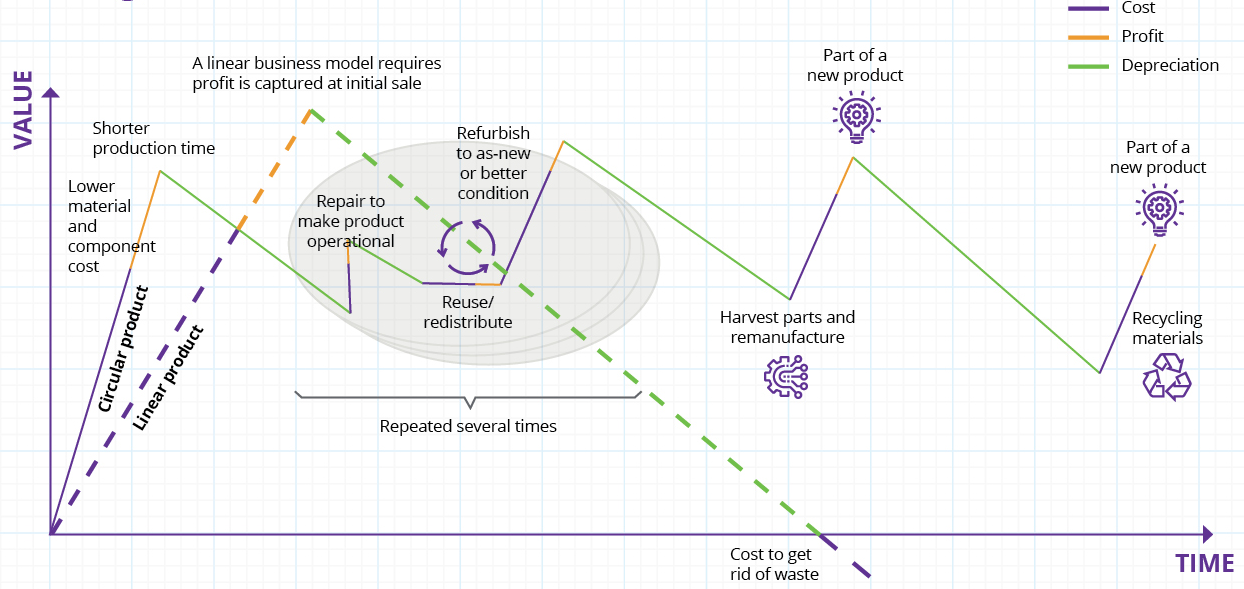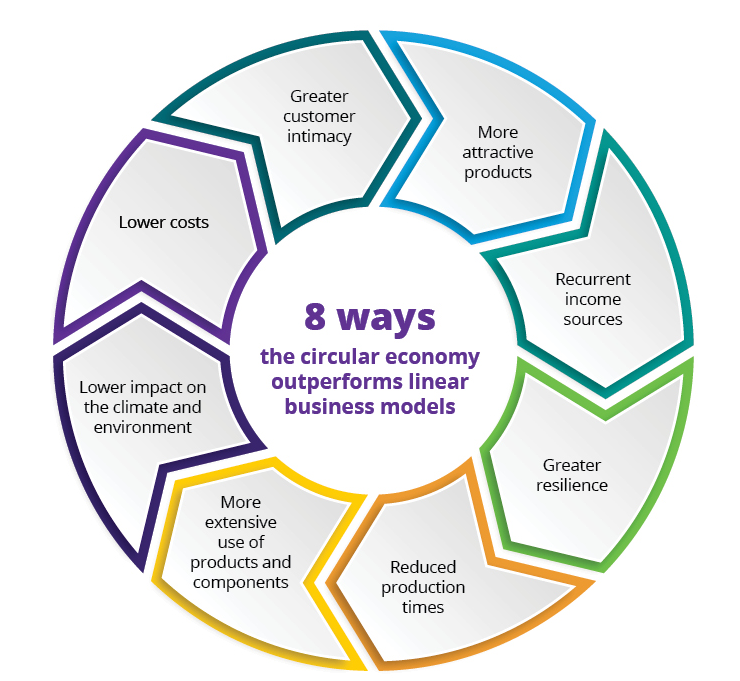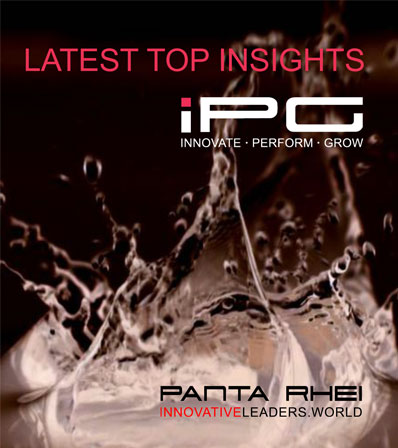Imagine an economy where resources get used but not used up; new business strategies keep products, components and materials in the system – during and after use – and where dangerous, dirty waste is at an absolute minimum.
You’ve just imagined the circular economy.
The circular economy moves the needle from traditional “linear” economies, where products are made, used and then discarded, although now sometimes recycled, reducing some waste. The circular economy goes much further by creating a virtuous circle around use that includes making, repairing, refurbishing, reusing, remanufacturing and recycling.

Circular economy transition: history repeating itself
Disruption is nothing new and we’ve seen it with “born-digital” start-ups, which have upended how pre-internet legacy organizations with traditional brick-and-mortar business models operate. Legacy firms that survived joined the wave and digitized their business models; those that didn’t faded away.
Similarly, companies that understood the railroad's advantage over steamships created mass production sites and crushed small, local plants that until then had dominated manufacturing. That transition has accelerated with the containerization of global trade.
Now, “born-circular” companies and their new competitive business models are about to disrupt “linear” organizations and erode their market positions. But, as we saw with the digital revolution, legacy businesses that can adopt new circular business models will survive.
The transition to circularity has political support, for example, the EU aims to transition to a circular economy to make Europe cleaner and more competitive. There is also support from customers. For example, Gartner predicts that by 2029, supply chains will not be allowed to produce waste, as customers and many governments will find it unacceptable. What’s more, this is happening quickly. By as soon as 2030, if your business model isn’t circular, you won’t be competitive.
8 advantages to circular businesses

Circular business models will outperform traditional linear models in eight important areas:
1. More attractive products
A recent study from McKinsey and NielsenIQ showed a link between ESG-related claims and consumer spending, increased loyalty and product growth. The Wharton School of the University of Pennsylvania found that consumers' reason to purchase sustainable products and brands was their intention to improve the environment (30%), reduce production waste (23%), reduce their carbon footprint (22%), and concerned with animal welfare (17%).
With circular business models, waste becomes an asset rather than a liability to discard. Renewable and recyclable inputs become essential parts of production, lowering or even eliminating waste, pollution and biodiversity loss, thereby strengthening the three main reasons for purchasing sustainable products.
2. Greater customer intimacy
In the linear economy, companies sell new products to the next in line and leave the continued customer dialogues to their downstream partners. For circular business models, next-in-line communication is not sufficient. They require continuous dialogue throughout the business ecosystem during the product's lifetime.
Circular organizations will offer product-as-a-service, in which a customer pays for the use of a service over a limited time. The provider maintains ownership of the product and remains incentivized for the product’s ongoing maintenance, durability, upgrade and treatment at the end of its use.
The sharing economy maximizes how idle assets are used across a community while providing customers with affordable and convenient access to products and services. These two circular business models, together with new recovery models, will offer more customer touchpoints, including during repairs, returns and upgrades. The increased intimacy enables a consistent dialogue that helps providers understand customer usage patterns and perceptions.
Continuous end-consumer dialogues will be a new experience for many providers and they need to learn how to make it relevant, timely and engaging.
3. Lower costs
Circular products are designed to be reused, repaired or refurbished and ultimately disassembled. Similarly, circular components are designed to be reconditioned, remanufactured and eventually recycled. As a result, materials and components cost less and the desired service from the product will be more cost-effective due to the product’s increased usage.
For example, Sweden-based bearings supplier SKF now offers oil-as-a-service with its RecondOil offering. It uses a double separation technology (DST) approach to remove even the smallest contaminants from oil to be cleaned and reused. Unlike previously, when an industrial seven-year production cycle might require 30 oil changes, oil-as-a-service can see the same seven years completed with no additional oil or logistical costs and no lost production time.
However, the circular economy does not provide cost reduction from day one, the transition of value creation, capture and delivery to circular business models requires investments and courageous business decisions.
4. Recurrent income sources
Circular business models involve recurrent selling not only in product-as-a-service and sharing-economy business models but also from the commerce of recovered components and materials, which generate an income every time they’re resold.
Related services like repairs, redistribution and refurbishment also bring recurrent income. Waste and by-products can be treated as assets too.
5. Greater resilience
Circular products have been designed so that when they’re no longer functional in their current application, their embedded components, materials, energy and other resources can be recovered. Users are incentivized to return the products by paying deposits or by the terms of their product-as-a-service contracts.
Organizations that control their production input by recovering components and recycling their materials (rather than disposing of them) can better withstand unstable supply chains, product shortages and finicky suppliers. They can also protect themselves against price fluctuations.
6. Greater product and component utility
Linear economy business models are designed around the user owning the product, which provides for poor utilization (e.g. cars are parked around 95% of the time).
Product-as-a-Service and sharing economy models ensure that product utilization is increased, enabling higher income per unit.
Circular products are designed to be reused, repaired, reconditioned and upgraded, which increases utilization. Similarly, components will be harvested and remanufactured and used again and the materials will ultimately be recycled.
7. Reduced production times
Products and components that stop working can be refurbished more quickly to as-new or to nearly new conditions, eliminating the need to manufacture many new product components.
One example can be found in wind power. Demand for wind turbines is currently so high that fulfilling orders take some manufacturers as long as two years. By contrast, an existing wind turbine can be refurbished and delivered in four months.
8. Climate and environmentally friendly
Recycling, repairing, refurbishing and re-using circular products require less energy and have less impact on the environment than conventional methods. This includes biodiversity loss, foresting and mining, component and product manufacturing and the transport of raw materials. Also, organizations that adopt safe disposal methods can lower their environmental impact.
The Global E-waste Monitor 2020 found that 53.6 million metric tonnes of e-waste was generated worldwide in 2019 (7.3 kilograms per capita), and this number is predicted to reach 74.7 megatonnes by 2030. Therefore, several manufacturers, importers and distributors have started an initiative to take responsibility for the end-of-life management of electronics.
One example is n2s, that advocate reuse in line with the European Hierarchy of Waste Management. N2s aims to reuse or redeploy devices first, with recycling a secondary outcome used for those items that are beyond economic repair. In 2021, n2s recycled 149.489 tonnes of PCBs and 189.914 tonnes of electric cable. That means they recovered 129 tonnes of copper last year alone. It would take between 12,900 and 20,640 tonnes of copper ore to yield the same amount of pure copper through traditional mining.


















